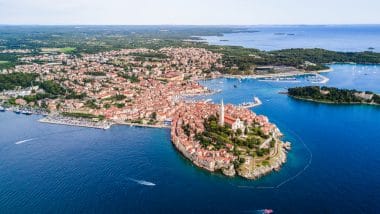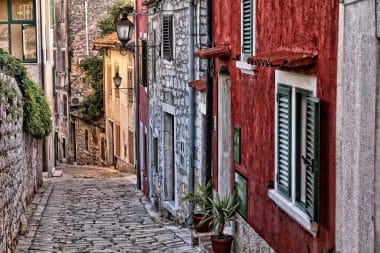Romantic, dreamy, Mediterranean: these are the buzzwords that come to mind when you think of the Croatian city of Rovinj. Some even think it is the most beautiful city in Croatia. The port town of Rovinj, which has only about 15,000 inhabitants, is located in the very north of the country, on the Istrian peninsula, directly on the Adriatic Sea. The history of the city is eventful.
In the second century AD, the Romans settled here. Later, Rovinj was under Byzantine rule. From the 13th century, Rovinj was Italian, later the Habsburgs took over, and finally the city was part of Yugoslavia. The Italians in particular have left their mark here: Rovinj is still bilingual – Croatian and Italian – and the Italian minority still makes up ten percent of the population. This is reflected in the way of life, as well as in the architecture and on the plate.
Mediterranean way of life between romantic bays and beaches

Rovinj is located on a narrow promontory that juts far out into the Adriatic Sea. Here, visitors still breathe the flair of a small fishing village, where time sometimes stands still. Those who like it particularly quiet will love the 22 small islands off the coast of the city. By boat, for example, you can quickly get to Crveni Otok, which translates as “Red Island”.
The landscape on the islands is still wild, and particularly charming. But there are also magical beaches on the mainland, such as Borik Beach or Lone Bay. In Istria, the beaches are made up of small pebbles. The water around Rovinj is crystal clear, which is especially pleasing to snorkelers and divers who want to explore the surrounding underwater world. There are several professional diving schools in Rovinj. Sports enthusiasts can also rent kayaks to explore the many coves lined up along the coast. In the sunset, they look particularly picturesque.
Winding and rocky: the historic old town of Rovinj

Especially in the hot midday hours, a walk through the shady old town of Rovinj is good. Istria has a Mediterranean climate: this means that the summer months can be very dry and hot.
The best time for a beach holiday is from June to September. In the remaining months, the climate is mild, which makes Rovinj an attractive holiday destination even in the low season. If you stroll through the old town alleys, you are walking on natural cobblestones. You enter the old town through the Venetian Porta Balbi, built in 1680. Here you can see the coat of arms of the winged Venetian lion. The Church of St. Euphemia is considered a landmark of Rovinj.
Its 60-metre-high church tower is visible from afar. But the interior of the church is also a feast for the eyes: the baroque church, built in the 18th century, is decorated with ornate paintings and Gothic statues. The alleys continue to wind their way to the Baptistery of the Holy Trinity. The heptagonal Romanesque church from the 12th century is the oldest building in the city, and for that reason alone it is worth a visit. Also from the 12th century is the glowing red Torre dell’Orologio: the clock tower.
In the past, it functioned as the south tower of the city wall, later as a prison. If you want to find out more about the history of the city, visit the local history museum before the old town walk leads through the streets of Trevisol and Garzotto. Here, between colourful houses with low doors and flower boxes, the wheel of time turns back and visitors feel wonderfully slowed down. Before heading back to the harbour, the Batana Museum invites you to take in historic wooden boats and fishing objects.
Between fjord and cave landscapes: magical excursions around Rovinj
Who would have thought that with the Limski Channel near Rovinj there is also a fjord to cross. The narrow inlet runs along the west coast of Istria. The low-salt fjord is best known for its fish and mussel farming. Oysters, seafood or Italian-inspired fish dishes, which end up on the plate in Rovinj’s restaurants in the evening, were often fished here.
Tourists like to take a boat trip through the nature reserve. The nature around the Linski Canal is wonderfully diverse. A real highlight is the cave of Romuald at the end of the Linski Canal. According to legend, the hermit Romuald lived here around 1,000 AD. The cave is a colourful stalactite cave that can be visited as part of guided tours.
If you prefer hiking to boating, the Limski Canal is the right place for you. A well-signposted hiking trail leads from Vrsar to Dvigrad, which can be mastered as a daily stage. The trail runs largely parallel to the Limski Canal. With the difference that you can now explore the waterway almost from a bird’s eye view, as the hiking trail is located high above the rocky cliffs. The destination of the hike is the ruined city of Dvigrad. The medieval village, which was once founded by the Illyrians, has been abandoned since 1631, and has been falling into disrepair ever since. Dvigrad used to be an important trading center. Two castle ruins and a lot of dilapidated sacred and secular buildings can be visited here. People once fled Dvigrad because plague and malaria had a firm grip on the city.


